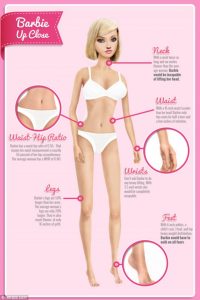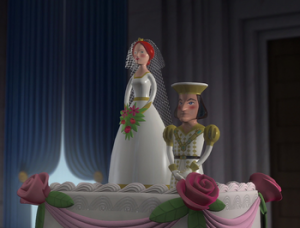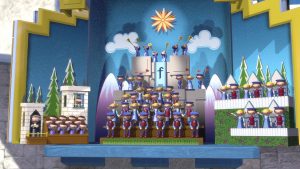Not too long ago, the Mattel fashion doll “Barbie” was a young girl’s favorite toy. Barbie and Ken could be found in nearly every toy chest, children using their imaginations to play out perfect fantasies with the dolls. And that became the goal, to not only obtain such a fantasy, but to look like Barbie. Unfortunately, that is entirely impossible. According to Daily Mail, if Barbie were an actual human, she would be “incapable of lifting her neck” due to her length to thickness ratio, her oversized head, the fact that there is “only have room for half a liver” due to her waist size, and due to her small feet in proportion to the rest of her frame she “would have to walk on all fours.”1 Children are left with a highly impractical notion of what is considered beautiful, chasing a dream which cannot be caught.

Similarly, traditional children’s movies have undergone some criticism for the ideologies they tend to push upon the impressionable viewers. On a casual viewing, they may appear to be simply good-hearted and inspirational, but realistically they are far from as innocent as their target audience. Rather, they do not remain free from society’s grasp; they are still fervent with ideology. These movies promulgate orthodox standards of beauty and fairytale dreams, which are often unrealistic and as a result, leave children with dreams that will ultimately fall short. However, it poses the question: is this always the case?
The Dreamworks film, Shrek, attempts to reject these beauty standards by having ogres as its main characters. So, this means the movie must be free from the shackles of restrictive gender norms then, right?
Indeed, Shrek is not your stereotypical idea of Prince Charming, which Princess Fiona even acknowledges when she first sees him take his helmet off. Yet when examined further, this break from the stereotypes is fairly surface level. Initially, when Lord Farquaad is searching for who he should recruit to rescue the princess, he gathers all of the top knights in DuLoc. He says to his guards, “Gather your best men.”2 This already insinuates the idea that the only members of society that could be tough enough to undergo such a quest are males rather than females. Such masculinist ideas are not uncommon, but are worth pointing out nonetheless. Further, even though Shrek is not one of the knights chosen by Lord Farquaad, let alone a knight at all, he still defiantly defeats all of the knights. In this way, he is not some meager being on this journey, even though he is slightly portrayed as the scrappy underdog figure when he sets out on this adventure. Rather, he is taller and stronger than any of the other knights that had been up for selection, making him in some ways an even more masculine figure than the others, pushing this perspective of height and strength being necessary for the valor.
Furthermore, it should be noted that the movie presents the proverbial plot with a princess in need of rescuing. While Princess Fiona is displayed later to be slightly more self-sufficient than previous movie princesses, she is still depicting as needing the help of some valiant person to free her, and is incapable of doing so on her own. This notion seems to be mostly in her head, as when Shrek arrives at her chamber, she closes her eyes and pretends to be asleep while she waits for him to kiss her, willingly submitting herself to this fairytale idea of a helpless damsel in distress. Throughout the rescuing process, she criticizes the situation for not being “how it’s supposed to be” as if life is not worth living if it is not in accordance with these fairy tale ideas.2 This ideology has been pushed upon her, manipulating her for so long through this royalty and magic community, and with her behavior in these scenes she continues to perpetuate and support these ideas. The princess has spent so long in this tower awaiting her happily ever after, and even with the ever so slightly more unconventional path taken to get there, at the finale of the movie the princess and her savior are pictured riding off into the sunset in their carriage. Happiness, in the case of this movie, is consistently associated with the finding of true love. The song playing while Shrek goes to the castle to rescue the princess even states, “I’m on my way from misery to happiness today.”2 Essentially, all of the sadness portrayed in the beginning of the film is chalked up to simply being loneliness while waiting to find true love, as if that will immediately solve all problems.
These clichéd gender roles are omnipresent throughout the film. Even before we are introduced to Princess Fiona, the magic mirror presents the “eligible bachelorettes” to Lord Farquaad as if they are prizes on a gameshow, then insinuating that these women are up for his ownership.2 In this case, the women are worth nothing more to Farquaad than a path to the crown. Essentially, Farquaad dehumanizes women by treating them as property or like a farm animal. Later, when they arrive at the castle and are searching for the dragon, Donkey asks Shrek, “Where is this fire breathing pain in the neck anyway?” to which Shrek retorts, “inside waiting for us to rescue her,” once again poking fun at women and their value to society.2 And these examples only continue. On the way back from the castle, the princess is constantly very demanding, and complains until Shrek physically shuts her up, demonstrating the idea that women are annoying for their chatter, and further that it is acceptable to exploit their physical dominance over a woman if she is being annoying. When Fiona feels bad about her actions in the morning, she wakes up early to cook breakfast for the males, which is yet another stereotype about how women belong in the kitchen, and that women’s worth is to carry out minor tasks for the man while the man’s job is to provide. In the same fashion, when they make camp at night, Fiona remarks that she needs to add some “homey touches” to the place, reinforcing the typical role of women as homemakers, as women can only be trusted for tasks such as decorating and cooking.2 Even in a movie where they attempt to make the princess seem like less like a classic royalty figure, with her willingness to belch publicly for example, the alterations made to her character are still fairly surface-level, not going any deeper than manners and the ogre exterior at night. Even as they try to make her seem tougher, when she fights Robin Hood’s men, the camera cuts to slow motion in the middle of a high-kick so that she can fix her hair. The directors cannot even manage to provide a full scene of the princess behaving in an independent, tough manner without throwing something in that resorts her back to the feminine role, showing her caring just as much about how she looks as she does with her own survival in this adrenaline-filled scene.
In addition to the reinforcement of the stereotypical gender roles of women, Shrek ridicules deviations from idealized masculinity. Lord Farquaad’s character embodies the penalties of toxic masculinity in drawn out and exemplified physical form. Shrek, being the tall, strong masculine character, consistently pokes fun at Lord Farquaad for his lack of height, a recurring point of humor in the film. For example, when Shrek and Donkey first arrive at Farquaad’s castle in DuLoc, noticing how oversized it is, Shrek notes, “Do you think he’s compensating for something?”2 While it is clear that he is speaking toward Farquaad being so small in stature and most likely his size below the belt as well, this insinuates that small stature is a deviation from the masculine ideal requiring compensation. Thusly, the film equates masculinity to height, reinforcing these notions of male gender roles in juxtaposition to the previously established female gender roles. Examples of this are sprinkled throughout, demonstrating Lord Farquaad’s attempts at “compensation,” such as when he has fake armor legs built into the side of his horse so that he looks tall when he arrives in front of Princess Fiona for the first time on his steed. Even on their wedding cake, Lord Farquaad has his cake topper set at the same height as Princess Fiona, to which she responds by pushing his further down into the cake.
All of this still equates to show the same principle, that being short is something that should be hidden, something that a male should find embarrassing because it is seen as a weakness.
A more intriguing point, however, can be made when it comes to the relationship between the fairytale creatures and the people of DuLoc. In the beginning scenes when Donkey is first introduced, the guards are lining up and enclosing the creatures in cages in exchange for money, as the townsfolk sell away the freedom of these creatures in a very inhumane manner. This is notably reminiscent of times throughout history with mass genocide, where the group that is inpower, considering themselves “normal,” sells out the other group as if they are merely objects, ostracizing them for being different. Lord Farquaad states that they are to go to “designated resettlement facilities,” which seems quite similar to how the Nazis called their camps for the Jewish people “concentration camps,” painting them in a much nicer light than what they really were.2 Essentially, Lord Farquaad is also trying to exterminate the magic creatures for being different, as they interfere with the “perfectly” white community that he is striving for. Even at the information booth, when the automated figures sing to Shrek and Donkey about how “DuLoc is a perfect place,” it is a figure full of all identical, white humans.2

The connection can then be made that everything is perfect when all differences are eliminated, continuing this Holocaust-reminiscent idea.
From a surface level view, Shrek makes some strides in a positive direction by avoiding a stereotypical princess or knight in shining armor, but their change in appearance is superficial, not belying any deeper subversion of gender norms. The persistent use of stereotypical gender roles accompanied by the clichéd notions of a happily-ever-after implant such ideals into the audience’s heads. And to top it all off, the movie even attempts to make a version of mass-genocide seem much more innocent and cartoonish, slipping in this idea in such a way that it does not appear to be as outright cruel and inhumane as it is in actuality, making it almost seem okay to the youngviewers that likely have not been taught of the Holocaust yet. Even “progressive” children’s movies apparently are much more tainted than they would initially appear to be.
Bibliography
1. Golgowski, Nina. “Bones so Frail It Would Be Impossible to Walk and Room for Only Half a Liver: Shocking Research Reveals What Life Would Be like If a REAL Woman Had Barbie’s Body.” Daily Mail Online, Associated Newspapers, 14 Apr. 2013.
- Barbie Doll Statistics http://www.statisticbrain.com/barbie-doll-statistics/
2. “The Internet Movie Script Database (IMSDb).” The Internet Movie Script Database, www.imsdb.com/scripts/Shrek.htm.